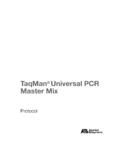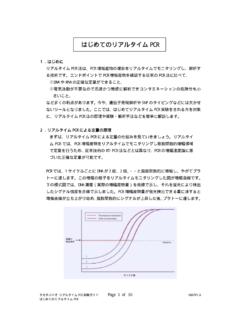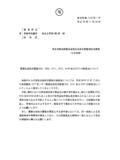Transcription of How to validate a qPCR method for transgene copy …
1 How to validate a qpcr method for transgene copy number determination in recombinant CHO cell lines to be in compliance with GMP (good manufacturing practice) in biopharmaceutical industry? Okr lar Veronika, kulj Mihaela, Dole al Jena, Andrej Francky Biopharmaceuticals, Cell and Molecular Biology Lek Pharmaceuticals Kolodvorska 27, SI-1234 Menge . Introduction copy number Tm C transgene Endogenous of endogenous Dilution 1 Dilution 2 Dilution 3 Dilution 4 Dilution 5 gene In biopharmaceutical industry stringent requirements are in place for the validation of ana- gene in reaction 10x 50x 100x 500x 1000x Sample lytical methods used for characterisation of products and cell lines producing them.
2 Genetic 8720 1580 671 143 63 Acceptance criterion 78-79 80-81. characterization of MCB (master cell bank) and WCB (working cell bank) prepared from a selected clone (CHO cell line) chosen for production, is one of the steps covered by GMP 8545 1653 730 133 83 Plasmid DNA /. Acceptance criterion 78-79 /. in the process of recombinant protein production development. In addition to sequencing, 8226 1923 707 134 84. Southern blot and Northern blot analysis, a qpcr method for transgene copy number deter- Genomic DNA from CHO / mination was introduced. For GMP purposes the qpcr based method has to be validated in Average 8497 1718 703 137 77 Acceptance criterion / 80-81.
3 A proper way according to the guidelines of ICH-International Conference on Harmonisation SD 251 180 12. (1), FDA- Food and Drug Administration (2,3). Particular assays were designed to determine Table 8: Test of specificity. Tm values are verified by using SybrGreen chemistry. Agreement the accuracy, precision (intra-assay, intermediate), specificity, selectivity, linearity, the limit of CV (%) between measured and predicted Tm values for specific amplicon is a measure of specificity. detection, the limit of quantification, range of quantification and test ruggedness and robust- ness of the developed method . copy number Sequencing of qpcr product Agreement of transgene in Dilution 1 Dilution 2 Dilution 3 Dilution 4 Dilution 5.
4 Reaction 10x 50x 100x 500x 1000x Amplicon of transgene on plasmid 100%. method description 109606 20084 7912 1752 Amplicon of transgene in sample 100%. transgene copy number determination by qpcr 97788 21198 9508 1716 Amplicon of endogenous gene in sample 100%. A real-time qpcr method for determination of copy number of the transgene integrated into the genome of Chinese hamster ovary (CHO) cell was established. The absolute quantifica- 106143 22068 9771 1893 Acceptance criterion 100% agreement with predicted sequence tion approach was applied. Specific amplicons on a single copy endogenous gene of the Average 104513 21117 9064 1787 CHO genome and on a specific transgene inserted in the recombinant plasmid were con- Table 9: Test of specificity.
5 Exact sequences were gained by sequencing. Agreement be- Graph 1: Determination of quantification range. Quantification range was demonstrated from structed. Standard curves were prepared from genomic DNA of nontransfected CHO cells SD 6075 995 1006 93 54 tween obtained and predicted sequences was confirmed. 1 to 200 copies of transgene per one copy of CHO cell genome. and extracted recombinant plasmid DNA. Five serial dilutions were prepared in the range CV (%) from 100-10000 copies per well (100pg/ l-10ng/ l) for genomic DNA and from 500-5x106. copies per well (10pg/ l-1fg/ l) for plasmid DNA. Genomic DNA from the transfected CHO Acceptance criterion CV (%) 20% Selectivity is the ability of a analytical method to measure and differentiate the analytes in the Ruggedness (reproducibility in ICH guideline(1)).
6 Cell line (sample) was also prepared in five serial dilutions in the same range as for the presence of components that are present or are expected to be present. The ruggedness of an analytical procedure is a measure of its capability to remain unaffected standard curve of genomic DNA of nontransfected CHO cells. Relative standard curves were Table 3: Test of intra-assay precision. copy number values were compared among parallels by normal, expected variations in method parameters during normal usage of the method . constructed for each sample and efficiency of amplification was calculated. The final reac- for 5 dilutions of sample.
7 CV in % is a measure of scatter. Selectivity of the method was proven by testing the ability of the method to amplify and detect Variable method parameters are different analysts, different days of analysis, different equip- tion volume was 9 l and each was prepared in triplicates. TaqMan chemistry was used and the specific target sequence in a mixture of recombinant plasmid and genomic DNA from ment, different lots of reagents ). analyses were performed on an Applied Biosystems Prism 7900HT. nontransfected CHO cells. The difference in Ct values between individual DNA and the DNA The following variations were examined: mixtures was determined.
8 After analysis results were evaluated. Dilutions where the SD (Standard Deviation) of three influence of two different lots of master mixes, two different lots of primers and probes Ratio of transgene copy number per cell (diploid). replicates was more than were not used for standard curve preparation and copy number Ct for transgene influence of two different extractions of plasmid and genomic DNA from nontransfected determination. Samples where efficiencies of amplification differed more than 10% from those Dilution 1 CHO cells used as standards Plasmid + water influence of two different analysts, who performed the whole analytical procedure of the standards were reanalysed.
9 The copy number was determined as a ratio between Dilution 2 transgene and endogenous gene copy number in the reaction ( copy number of transgene Plasmid + extracted genomic DNA from CHO influence of inter-day repeatability, the analysis was performed on two different days per haploid genome) and than multiplied with 2 or 4 to express copy number of transgene per Dilution 3 Difference cell ( copy number of transgene per diploid or tetraploid genome). Dilution 4 Validation of analytical method Dilution 5 Ct for endogenous gene The objective of validation of an analytical procedure is to demonstrate its suitability for the Average Extracted genomic DNA from CHO + water intended purpose (3).
10 The validity of a method should be verified by laboratory studies and SD Extracted genomic DNA from CHO + plasmid specific acceptance criteria which are set in advance should be achieved. Information of suc- cessful completion of such studies should be provided in the assay validation report. In this Difference CV (%) case study particular assays were designed to determine the accuracy, precision (intra-assay, Acceptance criterion Ct<1. intermediate), specificity, selectivity, linearity, the limit of detection, the limit of quantification, Acceptance criterion CV (%) 20%. range of quantification and test ruggedness and robustness of the developed real-time qpcr Table 10: Test of selectivity.





